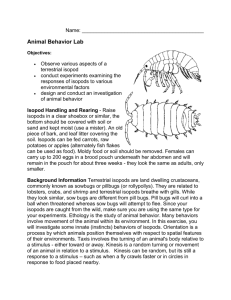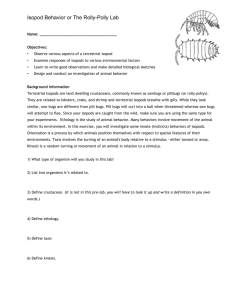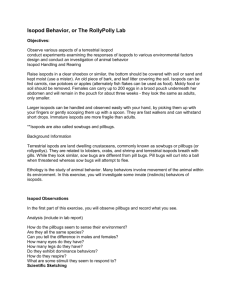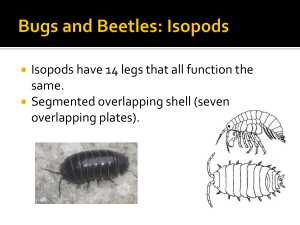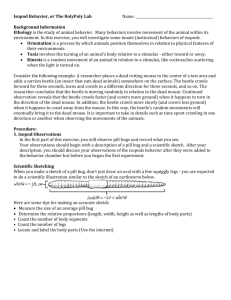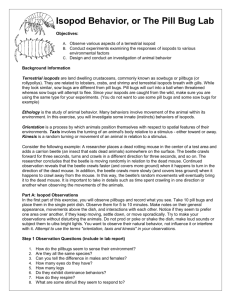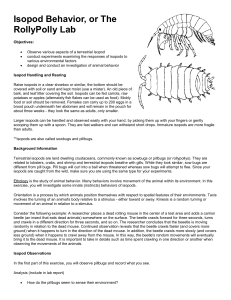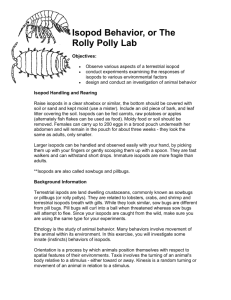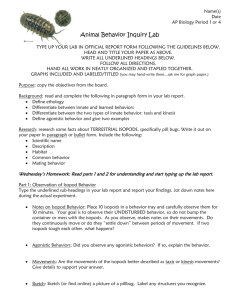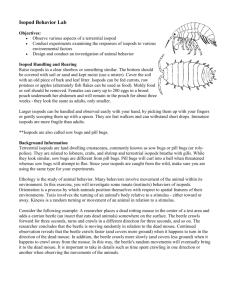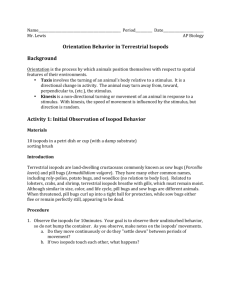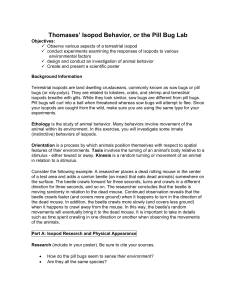doc file - The Biology Corner
advertisement
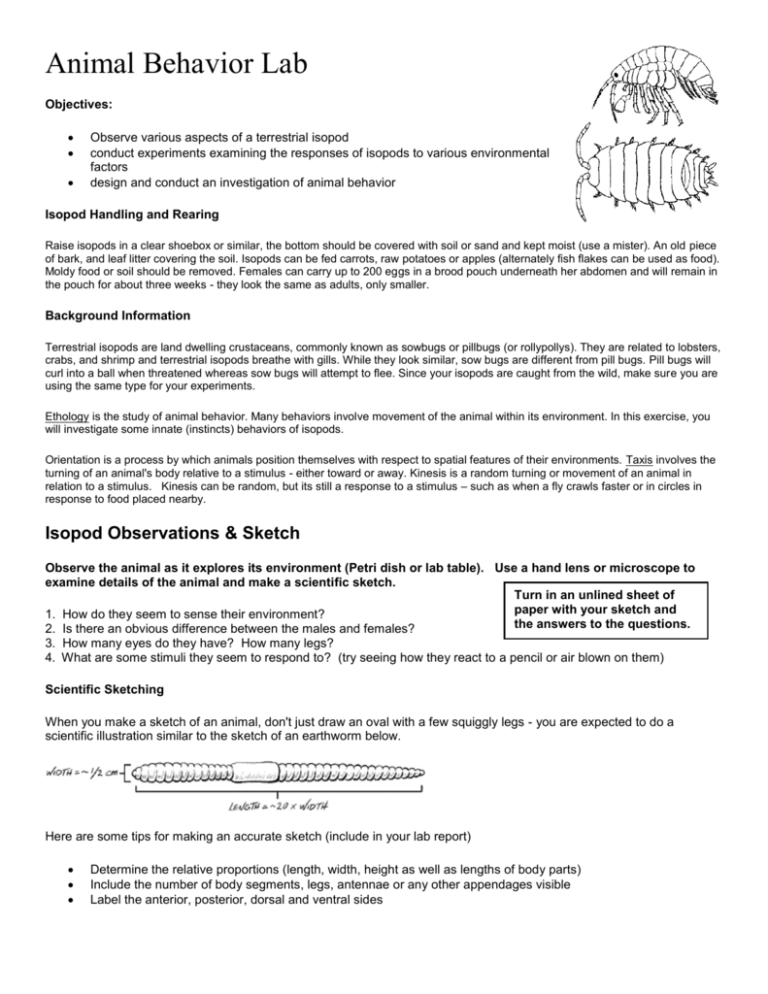
Animal Behavior Lab Objectives: Observe various aspects of a terrestrial isopod conduct experiments examining the responses of isopods to various environmental factors design and conduct an investigation of animal behavior Isopod Handling and Rearing Raise isopods in a clear shoebox or similar, the bottom should be covered with soil or sand and kept moist (use a mister). An old piece of bark, and leaf litter covering the soil. Isopods can be fed carrots, raw potatoes or apples (alternately fish flakes can be used as food). Moldy food or soil should be removed. Females can carry up to 200 eggs in a brood pouch underneath her abdomen and will remain in the pouch for about three weeks - they look the same as adults, only smaller. Background Information Terrestrial isopods are land dwelling crustaceans, commonly known as sowbugs or pillbugs (or rollypollys). They are related to lobsters, crabs, and shrimp and terrestrial isopods breathe with gills. While they look similar, sow bugs are different from pill bugs. Pill bugs will curl into a ball when threatened whereas sow bugs will attempt to flee. Since your isopods are caught from the wild, make sure you are using the same type for your experiments. Ethology is the study of animal behavior. Many behaviors involve movement of the animal within its environment. In this exercise, you will investigate some innate (instincts) behaviors of isopods. Orientation is a process by which animals position themselves with respect to spatial features of their environments. Taxis involves the turning of an animal's body relative to a stimulus - either toward or away. Kinesis is a random turning or movement of an animal in relation to a stimulus. Kinesis can be random, but its still a response to a stimulus – such as when a fly crawls faster or in circles in response to food placed nearby. Isopod Observations & Sketch Observe the animal as it explores its environment (Petri dish or lab table). Use a hand lens or microscope to examine details of the animal and make a scientific sketch. Turn in an unlined sheet of paper with your sketch and 1. How do they seem to sense their environment? the answers to the questions. 2. Is there an obvious difference between the males and females? 3. How many eyes do they have? How many legs? 4. What are some stimuli they seem to respond to? (try seeing how they react to a pencil or air blown on them) Scientific Sketching When you make a sketch of an animal, don't just draw an oval with a few squiggly legs - you are expected to do a scientific illustration similar to the sketch of an earthworm below. Here are some tips for making an accurate sketch (include in your lab report) Determine the relative proportions (length, width, height as well as lengths of body parts) Include the number of body segments, legs, antennae or any other appendages visible Label the anterior, posterior, dorsal and ventral sides The Behavior Chamber For the experiments you design, you will need to create a chamber to test the isopod’s reactions. Each basic chamber will consist of two sides, each side having a different environment, plus a tube that connects the chambers so that the isopods can move from one place to the other. You will be given the following materials, but the design of your chamber is up to you. Materials - plastic cups, straws, plastic bowls (or other things your teacher might provide for you). The same chamber can be used for multiple experiments. Part A - Orientation of Isopods in Response to Moisture Procedure: Set up your behavior chamber so that you have one side moist and one side dry (using paper towels). Transfer 4 isopods to each side of the chamber Count and record the number of animals on each side of the chamber every 30 seconds for ten minutes, using a table like the one below. Time (min:sec) # in Wet # in Dry Other Notes 0:00 0:30 1:00 1:30 2:00 2:30 3:00 3:50 4:00 4:30 5:00 5:30 6:00 6:30 7:00 7:30 8:00 8:30 9:00 9:30 10:00 Analysis 1. Based on your observations, do isopods prefer a moist or dry environment. 2. Would this movement be taxis or kinesis? 3. Suggest a reason why this behavior might be advantageous to an isopod? Part B - Student Designed Experiment -- Select TWO of the following factors to investigate. Factor Materials (suggested) Hypothesis – written as an if-then statement Temperature cold pack, warm pack Write Your Hypothesis: Light lamps, flashlights, dark construction paper, aluminum foil pH low pH (HCl), high pH (NaOH) Substrate (surface) soil, sand, sandpaper, bark, paper, cedar chips, gravel Odor Ammonia, acetone Food apple, potato, fish food, lunchmeat Other Organisms mealworms, crickets, superworms, earthworms Data Table : Fill in the top row with your chamber conditions (see data table from last experiment) Time (min:sec) Other Notes 0:00 0:30 1:00 1:30 2:00 2:30 3:00 3:50 4:00 4:30 5:00 5:30 6:00 6:30 7:00 7:30 8:00 8:30 9:00 9:30 10:00 Analysis: Based on your data, write a brief description of what happened in the experiment. Include whether you support or refute your hypothesis.
